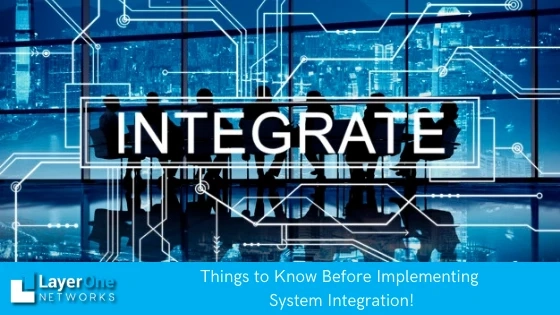Anyone in the IT sector considers a centralized network invaluable. And the system integration demand is tremendously valuable.
It booms in the market and isn\'t all that shocking. IT infrastructure in every industry has become a separate ecosystem. It is composed of different protocols and technology. System integration solutions solve every problem and customize it in a seamless way.
Rolling out a new solution needs high planning and effort throughout the whole engagement. The project manager never underestimates the effort required to integrate a system into an existing business.
During the upfront planning, they share with their team and customer using a collaboration tool. The project manager should plan the task from the beginning of the project, including the part of user acceptance testing. Otherwise, leaving this type of integration to the end leads to disaster.
IT consultant service will bring on this integration solution and help you focus on better performance.
What is system integration?
In broad terms, system integration is a process that combines different systems into a single one. Thus, it acts as one system. It is stated as a process that links various IT systems, services, and software together. Allow the system to work functionally.
The main reason companies utilize system integration is to improve the quality and productivity of their operation. The aim is to get the organization\'s IT systems to talk with each other through integration. As a result, it speeds up the information that reduces operational costs and flows for the organization. And also the third party that operates with the firm.
What is the purpose of system integration?
The goal of integration is to put this puzzle together. There are separate pieces of information that require to fit together into one. It is a mesh of cohesive architecture or integrated application. It is a complex process that connects an organization to a different system. And to streamline hardware, software, and communication.
The value of an integrated system is that an organization will improve working on a relationship with customers and partners. It will increase the efficiency of workflow. And lower the operational cost for business. System integration solutions can go through this networking, business process management, and manual programming.
Implementing a modernized B2B software integration platform offers you advantages of system integration. And also make your business move into a future-ready state. However, before you decide to have an integration platform, you must understand the types of it.
Nailed down 3 system integration methods
It is not simple to finalize the best-integrated solution. But, it depends on the company to select the best parts to deploy with precise location. Also, with partners and vendors to understand the necessary process, resources, and security needs. In return, it is with proper alignment that provides you a better value from the separate system, application, and software. So, let\'s go through the solutions.
Vertical Integration
Vertical integration is under the construction of system integration. It is a process that connects unrelated subsystems as one unit. Thus, each can get benefits to form the other. It is a vertically integrated concept known as "silos," where each layer works upward. It is a simple and fast method that consists of vendors, partners, and developers to begin with time. Also, it helps to expand the process and evolve it to a new function to meet business requirements.
Horizontal Integration
Horizontal system integration is also known as enterprise service bus (ESB). It is more than a one-off process. A special subsystem is created to communicate with other subsystems. The integrated strategy involves the creation of an application layer that allows programmatic connection between the application and ESB. And it becomes a proper system integration.
Point-to-point (Star) Integration
The star integration depends on a point-to-point method that connects each system to the remaining one. A series of connections look like a star polyhedron. It is the presentation of a figure that looks messy and interwoven, like a plate of noodles. When a company approaches SI through point-to-point integration, the neat IT infrastructure becomes disorganized.
Common data format
You can ensure reliable and accurate integration. It is for financial accounting, storage applications, and customer management. But, it is specific and often with single data formats. A high-performance solution will establish a standard format that removes the dependency. Enterprise application integration (EAI) will provide you independent data format and transformation service. It helps to alter between a format and application-specific format.
How to reduce System Integration Issues & Complexities
The development and IT department teams do not doubt with a new existing application. Instead, they embark on a digital transformation with different architecture formats. A single platform that provides you the ability to connect the best system integration services with processes that tackle software challenges.
Merge separate applications.
Built-in connector for common applications.
Automate the business process.
Reduce reliance on customized solutions.
Free up valuable resources for different projects.
A truly scalable approach
The organization should modernize its IT system to set not only IT agility but business as well. The shift to digital needs more flexibility so that companies can say yes to their customers. It also requires more on the back end to connect with data. Our IT consultant service firm will help your business globally to remove the issues and complexities that hinder it. The solution enables them to easily connect with an application, storage, and entire ecosystem.



